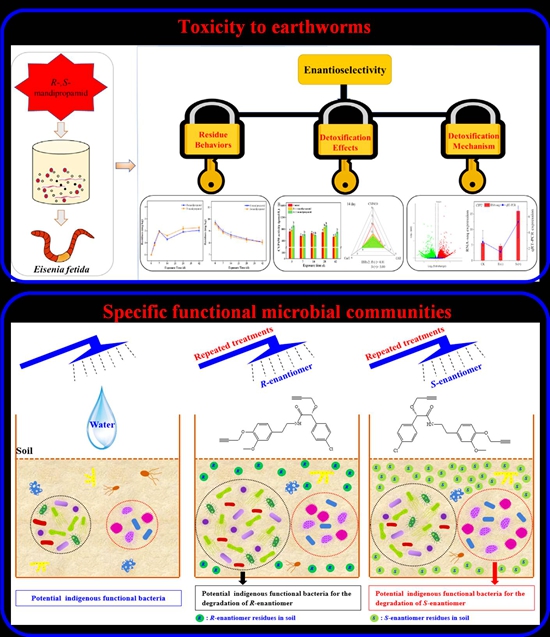Important Progress Made in the Study of Ecological Safety and Pollution Control of Chiral Amide Fungicides
Recently, the Innovation Team of Green Prevention and Control of Diseases and Pests in Tobacco Research Institute of Chinese Academy of Agricultural Sciences made important progress in the ecological safety and pollution control of chiral amide fungicides. They founded that the S-enantiomer of a chiral fungicide mandipropamid preferentially accumulated in earthworms compared with the R-enantiomer, but it could be preferentially degraded by specific indigenous functional microbial communities in soil. The research results were published in the international journal of the environmental field, Journal of Hazardous Materials and Science of the total Environment.
Fungicides have always played important roles in the control of crop diseases. In recent years, the amide fungicides have become the fastest growing class of fungicides in the pesticide market. How to accurately evaluate their ecotoxicity is of important significance for their reasonable use in practice. Moreover, it is of great significance to solve the residue problem of amide fungicides after long-term use and ensure the safety of cultivated land and human health.
The researchers selected a widely used worldwide amide fungicides mandipropamid as the target compound. The toxicity was firstly evaluated using earthworms as a model organism at the enantiomeric level. The results showed that mandipropamid consisted of S-enantiomer and R-enantiomer. The S-enantiomer accumulated faster than the R-mandipropamid in earthworms, which significantly affected the expression of genes associated with pollutant metabolisms, finally resulting in stronger toxic effects. Moreover, the potential microbial flora for the mandipropamid degradation were screened using the metagenomic sequencing and qPCR method. Haliangium and Sorangium were considered as the main indigenous functional bacterial genera that resulted in the preferential changes in the highly toxic S-enantiomer. These results could provide important basic data for the reasonable use of amide fungicides and the bioremediation of contaminated soil.
The research works were supported by the National Natural Science Foundation of China (No. 41977134, 41771352 and 42007376) and the Major Science and Technology Project of Green Control for Disease and Insect Pest (No. 110202101052 (LS-12)).

Original link:
1. https://doi.org/10.1016/j.jhazmat.2022.128961
2. https://doi.org/10.1016/j.scitotenv.2021.149051
By Wang Xiuguo (wangxiuguo@caas.cn)
-
 Apr 18, 2024Opening Ceremony of the Training Workshop on Wheat Head Scab Resistance Breeding and Pest Control in Africa Held in CAAS
Apr 18, 2024Opening Ceremony of the Training Workshop on Wheat Head Scab Resistance Breeding and Pest Control in Africa Held in CAAS -
 Apr 03, 2024IPPCAAS Co-organized the Training Workshop on Management and Application of Biopesticides in Nepal
Apr 03, 2024IPPCAAS Co-organized the Training Workshop on Management and Application of Biopesticides in Nepal -
 Mar 28, 2024Delegation from the School of Agriculture and Food Science of University College Dublin, Ireland Visit to IAS, CAAS
Mar 28, 2024Delegation from the School of Agriculture and Food Science of University College Dublin, Ireland Visit to IAS, CAAS -
 Mar 25, 2024Director of World Food Prize Foundation visited GSCAAS
Mar 25, 2024Director of World Food Prize Foundation visited GSCAAS -
 Mar 20, 2024Institute of Crop Sciences (ICS) and Syngenta Group Global Seeds Advance Collaborative Research in the Seed Industry
Mar 20, 2024Institute of Crop Sciences (ICS) and Syngenta Group Global Seeds Advance Collaborative Research in the Seed Industry
